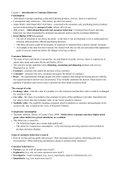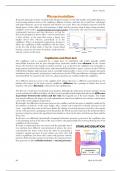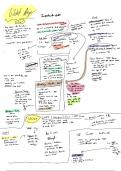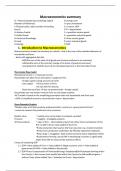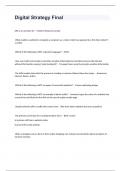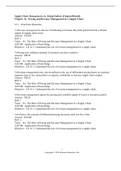Lecture 1 - Introduction to Consumer Behaviour
Consumption
• ‘Individuals or groups acquiring, using and disposing products, services, ideas or experiences’
• Consumption early references - 12th century up until 21st century
• Adam Smith / John Stuart Mill / Karl Marx - concerned with consumers only purchasing luxury products
and not understanding the concept of value, debate still relevant
• 20th century - Motivational Research and consumer behaviour = Emerged from Freud’s idea that
behaviour was often determined by irrational unconscious motives and by socialised inhibitions
• Ernst Ditcher (1947) recognised:
- The role of emotions in our choice decisions - at the time it was revolutionary to try to understand how
emotions and personality affected purchasing decisions
- That these decisions could not necessarily be analysed or explained from a purely rational viewpoint
- An example at the time was that everyone was fixated with one car: this car associated with aspirational
goals of success, American dream, the linkage to having a mistress
Consumer Behaviour
• The study of how individuals or groups buy, use and dispose of goods, services, ideas or experiences to
satisfy their needs and wants (Kotler and Keller, 2016)
• The activities people undertake when obtaining, consuming and disposing products and services
(Blackwell et at., 2016)
• Customer - someone who makes the decision to buy a product
• Consumer - someone who uses, consumes and enjoys the benefit of a product
• Buyer - (in organisational settings) people who select suppliers and manage the buying process whereby
the required products and services are procured. They formally undertake the process which leads to the
purchase of products and services once a decision has been made to procure them
The concept of value
• Exchange value - what the value of a product is to the consumer and therefore what it could be exchanged
for, usually its price
• Use value - the value of a product to the consumer in terms of the usefulness it provides. Sometimes the
use value is lower than the exchange value, in any luxury goods for instance
• Symbolic value - the symbolic meaning consumers attach to products to construct and participate in the
social world - this is linked to the views of Thorstein Vebelem
Conspicuous consumption
• Thorstein Vebelem, Theory of Leisure Class (1899). Veblen effect: consumer purchase higher-pried
goods when similar low priced substitutes are available
• This behaviour is caused by:
- The belied that higher price means high quality and
- The desire for conspicuous consumption = to be seen buying and using expensive items (linked to
prestige and status display)
Scope of consumer behaviour research
• How do we buy and use goods and services? How do people react to prices, advertising and store
environments? What underlying mechanisms operate to produce these responses?
Consumer behaviour is…
• Factual (e.g. are well-off people more loyal?)
• Explanative (e.g. why are some customers more loyal?)
• Investigative - many techniques (e.g. survey, experiment, analysis of Internet post, etc)
• Quantitative (e.g. how much more loyal?)
,Marketing and consumer behaviour
• Marketing is prescriptive (e.g. how should you operate as a marketer?)
• Consumer behaviour is descriptive (e.g. how consumers and industrial buyers do behave and react to
market intervention)
• The two approaches are linked (e.g. prescribe what works and don’t prescribe what doesn’t work)
• Practitioners may not know or may ignore evidence. The more knowledgeable person has an advantage.
How consumer behaviour insights help marketers
• The direction of an affect can sometimes fit common sense but.. what about the size boundary conditions
of the effect?
• How much do sales change when the price of a product is cut by 10%? What happens to sales after a
discount had ended? Why these effects occur?
• How much do colours, music and aromas affect consumers’ behaviour in a store? Which underlying
mechanisms explain any effects we see?
• When a new product is launched under an old brand name, how much does the old name affect the
purchase of the new product? Brand extension
Choices on which product to buy
Problems with comprehensive / rational models
• Difficult to find satisfactory measures for all the components (Ehrenberg, 1988)
• Overstate rationality of how consumers choose
• These models might suggest what people ought to do (normative) but they often offer little insights in
what people actually do (descriptive
Bounded rationality and satisficing
• Herber Simon (1955) proposes the idea of bounded rationality
• The number of alternatives, the amount of data and information needed, and the complexity of the task,
often requires a certain degree of approximation
• Satisficing= the view that decision-makers are not only driven by utility maximisation but the by the need
to reach a satisfactory enough solution to a problem or choice (Einhorn and Hogarth, 1981; Kahneman,
2003)
Behavioural insights
• Economists present consumers as behaving rationally in the assessment of costs and benefits
• However, consumer behaviour is more complex. Behavioural insights thinking / behavioural economics
perspective:
• Focuses on the contexts of decisions
• Emphasis is on the environment within which consumption choices take place
• The context of decisions can nudge people towards particular behaviours this often requires minor
changes in the environment. Choice architecture = how a choice is presented influences the choices
made - example: putting the lowest priced items near the paying area
,Models of consumer choice
Cognitive model : rational choice
• Consumers consider and evaluate evidence, so marketers need to:
- Control consumer behaviour with information
- Make factual claims in advertising
• Requires the decision-maker to have knowledge, time and processing capacity
- But how much do people use information sources?
- Do they always have a second alternative?
• Rationality is often partial, as in satisficing
• The “spectrum” of decision making ranging from rational to automatic is related to degree of
involvement
• Rational processing does occur but its rare… why?
Reinforcement model - introduces the idea of environment and its influence in consumer decision
• Reinforcer = an experience which raises the frequency of responses associated with it (punisher reduces
the frequency of such responses) operant conditioning
- Reinforces : rewards, cost reductions
- Punishers : costs, reward reductions
• Reinforcement = has most effect when it occurs at the same time as, or just after, the response
- Reinforcement changes the frequency of the response
- Reinforcement strengthens the association between the stimulus and the response
•Stimulus - response -
reinforcement that either
stimulates or hampers your
behaviour. The stamp in caffe
Nero for instance is a positive
reinforcement, neurofen instead
is associated with removing
something negative hence
negative reinforcement
, Habit model : habits of purchase - d
• Much consumption has a settled form; People have an habit when they produce
the same behaviour on encountering a particular stimulus (e.g. colour, size and shape of the pack);
• In this case, response is automatic - no conscious though is required;
• Previous learning in other situations might became habitual (habit repertoire) and can be called upon
even when making a complex decision;
• Although there is no conscious planning before the action, people might reflect on actions after the
purchase;
• Habitual purchase is frequently satisfactory? Why? Because if you get the same outcome every time you
purchase something, you make a positive association and hence next time you’re facing that specific
consumption decision you already know the outcome is going to be positive/satisfactory for you
Three models of consumer decision
Summary
• In this class we introduced a brief history of consumption and discussed the territory and scope of
consumer behaviour;
• We introduced the key concepts of bounded rationality and satisficing, proposed a behavioural
economic / behavioural insights perspective and discussed how automatic and controlled/reflective
processes could affect consumer behaviour - these topics will be explored further throughout the module;
• Key consumer behaviour questions are linked to marketing strategy and consumer policy problems (and
opportunities). To answer these questions we need to understand how consumers make decisions
• When people face difficult and involving choices, the cognitive model of choice may describe the process
of decision making (but the process is often simplified);
• When action is steered by the environment, the reinforcement model provides an explanation of how
purchasing is learned (actions are constrained by opportunities available and directed by the rewards and
costs present);
• When actions (such as a brand purchase) are learned, they might be induced by specific stimuli, such as a
brand name - in this case the habit model of decision making applies.
Consumption
• ‘Individuals or groups acquiring, using and disposing products, services, ideas or experiences’
• Consumption early references - 12th century up until 21st century
• Adam Smith / John Stuart Mill / Karl Marx - concerned with consumers only purchasing luxury products
and not understanding the concept of value, debate still relevant
• 20th century - Motivational Research and consumer behaviour = Emerged from Freud’s idea that
behaviour was often determined by irrational unconscious motives and by socialised inhibitions
• Ernst Ditcher (1947) recognised:
- The role of emotions in our choice decisions - at the time it was revolutionary to try to understand how
emotions and personality affected purchasing decisions
- That these decisions could not necessarily be analysed or explained from a purely rational viewpoint
- An example at the time was that everyone was fixated with one car: this car associated with aspirational
goals of success, American dream, the linkage to having a mistress
Consumer Behaviour
• The study of how individuals or groups buy, use and dispose of goods, services, ideas or experiences to
satisfy their needs and wants (Kotler and Keller, 2016)
• The activities people undertake when obtaining, consuming and disposing products and services
(Blackwell et at., 2016)
• Customer - someone who makes the decision to buy a product
• Consumer - someone who uses, consumes and enjoys the benefit of a product
• Buyer - (in organisational settings) people who select suppliers and manage the buying process whereby
the required products and services are procured. They formally undertake the process which leads to the
purchase of products and services once a decision has been made to procure them
The concept of value
• Exchange value - what the value of a product is to the consumer and therefore what it could be exchanged
for, usually its price
• Use value - the value of a product to the consumer in terms of the usefulness it provides. Sometimes the
use value is lower than the exchange value, in any luxury goods for instance
• Symbolic value - the symbolic meaning consumers attach to products to construct and participate in the
social world - this is linked to the views of Thorstein Vebelem
Conspicuous consumption
• Thorstein Vebelem, Theory of Leisure Class (1899). Veblen effect: consumer purchase higher-pried
goods when similar low priced substitutes are available
• This behaviour is caused by:
- The belied that higher price means high quality and
- The desire for conspicuous consumption = to be seen buying and using expensive items (linked to
prestige and status display)
Scope of consumer behaviour research
• How do we buy and use goods and services? How do people react to prices, advertising and store
environments? What underlying mechanisms operate to produce these responses?
Consumer behaviour is…
• Factual (e.g. are well-off people more loyal?)
• Explanative (e.g. why are some customers more loyal?)
• Investigative - many techniques (e.g. survey, experiment, analysis of Internet post, etc)
• Quantitative (e.g. how much more loyal?)
,Marketing and consumer behaviour
• Marketing is prescriptive (e.g. how should you operate as a marketer?)
• Consumer behaviour is descriptive (e.g. how consumers and industrial buyers do behave and react to
market intervention)
• The two approaches are linked (e.g. prescribe what works and don’t prescribe what doesn’t work)
• Practitioners may not know or may ignore evidence. The more knowledgeable person has an advantage.
How consumer behaviour insights help marketers
• The direction of an affect can sometimes fit common sense but.. what about the size boundary conditions
of the effect?
• How much do sales change when the price of a product is cut by 10%? What happens to sales after a
discount had ended? Why these effects occur?
• How much do colours, music and aromas affect consumers’ behaviour in a store? Which underlying
mechanisms explain any effects we see?
• When a new product is launched under an old brand name, how much does the old name affect the
purchase of the new product? Brand extension
Choices on which product to buy
Problems with comprehensive / rational models
• Difficult to find satisfactory measures for all the components (Ehrenberg, 1988)
• Overstate rationality of how consumers choose
• These models might suggest what people ought to do (normative) but they often offer little insights in
what people actually do (descriptive
Bounded rationality and satisficing
• Herber Simon (1955) proposes the idea of bounded rationality
• The number of alternatives, the amount of data and information needed, and the complexity of the task,
often requires a certain degree of approximation
• Satisficing= the view that decision-makers are not only driven by utility maximisation but the by the need
to reach a satisfactory enough solution to a problem or choice (Einhorn and Hogarth, 1981; Kahneman,
2003)
Behavioural insights
• Economists present consumers as behaving rationally in the assessment of costs and benefits
• However, consumer behaviour is more complex. Behavioural insights thinking / behavioural economics
perspective:
• Focuses on the contexts of decisions
• Emphasis is on the environment within which consumption choices take place
• The context of decisions can nudge people towards particular behaviours this often requires minor
changes in the environment. Choice architecture = how a choice is presented influences the choices
made - example: putting the lowest priced items near the paying area
,Models of consumer choice
Cognitive model : rational choice
• Consumers consider and evaluate evidence, so marketers need to:
- Control consumer behaviour with information
- Make factual claims in advertising
• Requires the decision-maker to have knowledge, time and processing capacity
- But how much do people use information sources?
- Do they always have a second alternative?
• Rationality is often partial, as in satisficing
• The “spectrum” of decision making ranging from rational to automatic is related to degree of
involvement
• Rational processing does occur but its rare… why?
Reinforcement model - introduces the idea of environment and its influence in consumer decision
• Reinforcer = an experience which raises the frequency of responses associated with it (punisher reduces
the frequency of such responses) operant conditioning
- Reinforces : rewards, cost reductions
- Punishers : costs, reward reductions
• Reinforcement = has most effect when it occurs at the same time as, or just after, the response
- Reinforcement changes the frequency of the response
- Reinforcement strengthens the association between the stimulus and the response
•Stimulus - response -
reinforcement that either
stimulates or hampers your
behaviour. The stamp in caffe
Nero for instance is a positive
reinforcement, neurofen instead
is associated with removing
something negative hence
negative reinforcement
, Habit model : habits of purchase - d
• Much consumption has a settled form; People have an habit when they produce
the same behaviour on encountering a particular stimulus (e.g. colour, size and shape of the pack);
• In this case, response is automatic - no conscious though is required;
• Previous learning in other situations might became habitual (habit repertoire) and can be called upon
even when making a complex decision;
• Although there is no conscious planning before the action, people might reflect on actions after the
purchase;
• Habitual purchase is frequently satisfactory? Why? Because if you get the same outcome every time you
purchase something, you make a positive association and hence next time you’re facing that specific
consumption decision you already know the outcome is going to be positive/satisfactory for you
Three models of consumer decision
Summary
• In this class we introduced a brief history of consumption and discussed the territory and scope of
consumer behaviour;
• We introduced the key concepts of bounded rationality and satisficing, proposed a behavioural
economic / behavioural insights perspective and discussed how automatic and controlled/reflective
processes could affect consumer behaviour - these topics will be explored further throughout the module;
• Key consumer behaviour questions are linked to marketing strategy and consumer policy problems (and
opportunities). To answer these questions we need to understand how consumers make decisions
• When people face difficult and involving choices, the cognitive model of choice may describe the process
of decision making (but the process is often simplified);
• When action is steered by the environment, the reinforcement model provides an explanation of how
purchasing is learned (actions are constrained by opportunities available and directed by the rewards and
costs present);
• When actions (such as a brand purchase) are learned, they might be induced by specific stimuli, such as a
brand name - in this case the habit model of decision making applies.

